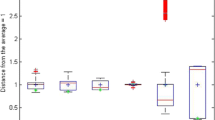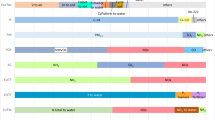Abstract
Background, aim and scope
The methodological choices and framework to assess environmental impacts in life cycle assessment are still under discussion. Despite intensive developments worldwide, few attempts have been made hitherto to systematically present the role of different factors of characterisation models in life cycle impact assessment (LCIA). The aim of this study is to show how European average and country-dependent characterisation factors for acidifying and eutrophying emissions differ when using (a) acidifying and eutrophying potentials alone, (b) depositions from an atmospheric dispersion model or (c) critical loads in conjunction with those depositions. Furthermore, in the latter case, the contributions of emissions, an atmospheric transport model and critical loads to changes in characterisation factors of NO2 are studied. In addition, the new characterisation factors based on the accumulated exceedance (AE) method are presented using updated emissions, a new atmospheric transport model and the latest critical loads.
Materials and methods
In this study, characterisation factors for acidifying and eutrophying emissions are calculated by three different methods. In the ‘no fate’ (NF) methods, acidifying and eutrophying potentials alone are considered as characterisation factors. In the ‘only above terrestrial environment’ (OT) approach, characterisation factors are based on the deposition of the acidifying or eutrophying substances to terrestrial land surfaces. The third method is the so-called AE method in which critical loads are used in conjunction with depositions. The results of the methods are compared both at the European and the country level using weighted mean, weighted standard deviation, minimum and maximum values. To illustrate the sensitivity of the AE method, changes in European emissions, employed atmospheric dispersion model and the critical loads database are conducted step-by-step, and the differences between the results are analysed.
Results and discussion
For European average characterisation factors, the three characterisation methods of acidification produce results in which the contributions of NH3, NO2 and SO2 to the acidification indicator do not differ much within each method when 1 kg of each acidifying substance is emitted. However, the NF methods cannot describe any spatial aspects of environmental problems. Both OT and AE methods show that the spatial aspects play an important role in the characterisation factors. The AE method results in greater differentiations between country-dependent characterisation factors than does the OT method. In addition, the results of the AE and OT methods differ from each other for individual countries. A major shortcoming of the OT approach is that it does not consider the sensitivity of the ecosystems onto which the pollutants are deposited, whereas the AE approach does. In the case of the AE method, a new atmospheric dispersion model, new information on emissions and critical loads have a different influence on the characterisation factors, depending on the country. The results of statistics show that the change in the atmospheric dispersion model has a greatest influence on the results, since ecosystem-specific depositions are taken into account for the first time.
Conclusions and recommendations
The simple NF methods can be used in a first approximation to assess the impacts of acidification and terrestrial eutrophication in cases where we do not know where the emissions occur. The OT approach is a more advanced method compared with the NF method, but its capability to describe spatial aspects is limited. The AE factors are truly impact-oriented characterisation factors and the information used here represents the current best knowledge about the assessment practice of acidification and terrestrial eutrophication in Europe. The key message of this study is that there is no shortcut to achieving advanced characterisation of acidification and terrestrial eutrophication: an advanced methodology cannot develop without atmospheric dispersion models and information on ecosystem sensitivity.






Similar content being viewed by others
References
Amann M, Cofala J, Heyes C, Klimont Z, Schöpp W (1999) The RAINS model: a tool for assessing regional emission control strategies in Europe. Pollut Atmos 20:41–46
Bare JC, Norris GA, Pennington DW, McKone T (2003) TRACI: the US EPA’s tool for the reduction and assessment of chemical and other environmental impacts. J Ind Ecol 6(3–4):49–78
Bouwman AF, Van Vuuren DP, Derwent RG, Posch M (2002) A global analysis of acidification and eutrophication of terrestrial ecosystems. Water Air Soil Pollut 141:349–382
EMEP (1998) Transboundary acidifying air pollution in Europe. EMEP/MSC-W Report 1/98. Norwegian Meteorological Institute, Oslo, Norway
Hauschild M, Potting J (2005) Spatial differentiation in life cycle assessment. The EDIP2003 methodology. Report No 80, Danish Ministry of the Environment. Environmental Protection Agency, Copenhagen, Denmark
Heijungs R, Guinée JB, Huppens G, Lankreijer RM, Udo de Haes HA, Wegener Sleeswijk A, Ansems AMM, Eggels PG, Van Duin R, De Goede HP (1992) Environmental life-cycle assessments of products. NOH Report 9266. Institute of Environmental Sciences, Leiden, The Netherlands
Hettelingh J-P, Posch M, De Smet PAM, Downing RJ (1995a) The use of critical loads in emission reduction agreements in Europe. Water Air Soil Pollut 85:2381–2388
Hettelingh J-P, Sverdrup H, Zhao D (1995b) Deriving critical loads for Asia. Water Air Soil Pollut 85:2565–2570
Hettelingh J-P, Posch M, De Smet PAM (2001) Multi-effect critical loads used in multi-pollutant reduction agreements in Europe. Water Air Soil Pollut 130:1133–1138
Hettelingh J-P, Posch M, Potting J (2005) Country-dependent characterisation factors for acidification in Europe—a critical evaluation. Int J Life Cycle Assess 10(3):177–183
Hettelingh J-P, Posch M, Slootweg J, Reinds GJ, Spranger T, Tarrason L (2007) Critical loads and dynamic modelling to assess European areas at risk of acidification and eutrophication. Water Air Soil Pollut: Focus 7:379–384
Huijbregts MAJ, Schöpp W, Verkuilen E, Heijungs R, Reinders L (2001) Spatially explicit characterisation of acidifying and eutrophying air pollution in life-cycle assessment. J Ind Ecol 4(3):125–142
ISO (2006a) ISO 14040: environmental management—life cycle assessment—principles and framework. International Organization for Standardization, Geneva
ISO (2006b) ISO 14044: environmental management—life cycle assessment—requirements and guidelines. International Organization for Standardization, Geneva
Krewitt W, Trukenmüller A, Bachmann TM, Heck T (2001) Country-specific damage factors for air pollutants: a step towards site dependent life cycle impact assessment. Int J Life Cycle Assess 6(4):199–210
Norris AG (2003) Impact characterization in the tool for reduction and assessment of chemical and other environmental impacts. Methods for acidification, eutrophication and ozone formation. J Ind Ecol 6(3–4):79–101
Ouimet R, Arp PA, Watmough SA, Aherne J, Demerchant I (2006) Determination and mapping critical loads of acidity and exceedances for upland forest soils in Eastern Canada. Water Air Soil Pollut 172:57–66
Posch M, Hettelingh J-P, De Smet PAM (2001) Characterization of critical load exceedances in Europe. Water Air Soil Pollut 130:1139–1144
Potting J, Hauschild M (2004) Background for spatial differentiation in life cycle impact assessment—the EDIP2003 methodology. Danish Environmental Protection Agency, Denmark
Potting J, Schöpp W, Blok K, Hauschild M (1998) Site-dependent life cycle impact assessment of acidification. J Ind Ecol 2(2):63–87
Seppälä J, Posch M, Johansson M, Hettelingh J-P (2006) Country-dependent characterisation factors for acidification and terrestrial eutrophication based on accumulated exceedance as an impact category indicator. Int J Life Cycle Assess 11(6):403–416
Tarrason L, Jonson JE, Fagerli H, Benedictow A, Wind P, Simpson D, Klein H (2003) Transboundary acidification, eutrophication and ground level ozone in Europe, part III; source-receptor relationships. EMEP Report 1/2003, Norwegian Meteorological Institute, Oslo, Norway. Available at http://www.emep.int
Tarrason L, Fagerli H, Klein H, Simpson D, Benedictow AC, Vestreng V, Riegler E, Emberson L, Posch M, Spranger T (2006) Transboundary acidification, eutrophication and ground level ozone in Europe from 1990 to 2004 in support for the review of the Gothenburg protocol. EMEP Report 1/2006, Norwegian Meteorological Institute, Oslo, Norway. Available at http://www.emep.int
Van Zelm R, Huijbregts MAJ, Van Jaarsveld HA, Reinds GJ, De Zwart D, Van de Meent D (2007) Time horizon dependent characterization factors for acidification in life-cycle assessment based on forest plant species occurrence in Europe. Environ Sci Technol 41(3):922–927
Acknowledgement
We thank the EMEP Meteorological Synthesizing Centre-West at the Norwegian Meteorological Institute for providing deposition data and the APD project at IIASA for providing the emission projections used in this paper.
Author information
Authors and Affiliations
Corresponding author
Additional information
Responsible editor: Ralph K. Rosenbaum
Appendix
Appendix
Rights and permissions
About this article
Cite this article
Posch, M., Seppälä, J., Hettelingh, JP. et al. The role of atmospheric dispersion models and ecosystem sensitivity in the determination of characterisation factors for acidifying and eutrophying emissions in LCIA. Int J Life Cycle Assess 13, 477–486 (2008). https://doi.org/10.1007/s11367-008-0025-9
Received:
Accepted:
Published:
Issue Date:
DOI: https://doi.org/10.1007/s11367-008-0025-9




